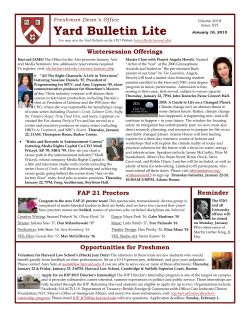
PIN App Owner Town Hall Presentation, March 2015
Identity and Access Management PIN App Owner Town Hall Meeting March 31, 2015 Tuesday 3:00 – 4:30 p.m. Taubman, T-520 (HKS) Agenda • Meeting Purpose and Intended Outcomes • Rollout of HarvardKey – Explanation of the new unified credential (15 min) • Explanation of Current State (30 min) – Authentication, Authorization, and Attributes – Potential Scenarios and Considerations • Options for HarvardKey Integration (20 min) • Discussion, Questions, Concerns (20 min) • Follow-Up and Next Steps (5 min) 2 Meeting Purpose and Intended Outcomes Purpose To provide Application Owners (of apps using the PIN2 service and allowing multiple credentials) information on HarvardKey and potential integration scenarios Intended Outcomes • Understand the current configuration of all applications • Discuss HarvardKey rollout strategy and its technical aspects • Provide options on how best to integrate with the HarvardKey • Determine best path for each application and next steps 3 HarvardKey for the End User The new HarvardKey will offer a single credential for access to most applications across the University • Log in to your desktop, check your email, use your Web apps … all using the same login name and password • Easier-to-use self-service features for common tasks like changing your password • Options for two-step verification via phone for even greater security • Rollout begins in September for Alumni and for others in October. This rollout will be done in conjunction with the Security Outreach Campaign in order to optimize communication with users 4 HarvardKey for People Administrators Improvements in onboarding, account management, and sponsored affiliation processes make work easier for people administrators. • Easier onboarding, including self-service account claiming and some automatic provisioning • Account management will be easier for both users and people administrators • Sponsored affiliations will fit within the POI user classification, with simpler, more streamlined setup 5 Current State: Authentication, Authorization, Attributes Authentication (PIN system handles) • User successfully supplied the password Authorization (application responsibility) • • The application compares the user name that is provided in the authentication response to a local list of named users An authorization proxy ‘rule’ can be used (PIN with an authorization filter) (e.g. ‘active employee’ OR ‘active temporary employee’) • Attributes included within the authentication response are used by the application to analyze each user as they are passed on to the application (e.g. ‘student or class participant at FAS’ OR ‘student at DCE’) • • Attributes are queried from HU-LDAP (or another local authoritative repository) using the unique user name that was provided in the authentication response No authorization used (anyone who successfully supplies the correct password can access the resource) 6 Why are you here? What is the concern? Currently, the authentication response contains different information depending on what type of user authenticated (which radio button was selected) With use of the HarvardKey, login options begin to consolidate: Alumni login = HarvardKey HUID holder = HarvardKey FAS/Central = HarvardKey When the someone uses HarvardKey, there is no way to determine if they are an Alumni, an Employee or Student or have a FAS sponsored affiliation/POI, etc. So depending on what the authorization approach is, your application may not be able to differentiate between types of users adequately. 7 Discussion of Integration with Login Option HUID + Today Contains an id type indicator No id type for differentiation (all HarvardKey) If the HUID radio button was selected, value contains a HUID Value will always be = HUID If Alumni option selected, value contains a HAA ID (Advance ID) Solution? Future:HarvardKey id_type indicators: ‘P’ for Harvard’s HUID ‘M’ for the HMS eCommons ‘A’ for the Alumni ‘X’ for XID system Solution If the type of user who is authenticating into the application is irrelevant, then there is no issue. To figure out id type of Alum or eCommons holder requires requesting and using additional attributes However, this implies the application is not using authorization (and will not be migrating to use HUIDbased authorization). NameID = HUID Always send all the login types Attributes: ‘harvardEduAlumniId’ ‘harvardEduHMSId’ Look-up all the user’s identifiers, and include them. Authorization model must be reevaluated 8 Options for Integration With Adapt your application to expect HUIDs for all populations, regardless of whether they are Alumni or not: Considerations: The applications local named-users list may be expressed in HAA IDs, these would need to be converted to HUIDs eCommons system does not have HUIDs for the self-registered population Migrate to CAS or SAML which can provide attributes (but no authorization rule): Considerations: There is no eCommons attribute service (yet) CAADS/Alumni attribute service exists, but is being integrated with PIN/CAS and PIN/SAML Migrate to use the AuthProxy token in order to get attributes for various user login types; potentially use an authorization rule? Considerations: AuthProxy token format is proprietary format; using it requires development (by applications) Create new AuthProxy token format to support multiple login types - IAM Development Use multiple registrations? 9 Important Points To Consider • Are all the registrations with PIN system that exist today still needed? (If no longer needed, please email iam_help@harvard.edu) • What does the application do with the authentication response today? • What authorization look-up method is used to determine who should get access to the resources? • Does the application rely only on ID type to for its authorization logic? If yes, this situation is the most affected by HarvardKey (multiple identifiers will be sent for some users). • Is the option to use multiple registrations for a single login type viable? PIN registration name can give additional information. • If using PIN2 service today, and attributes are required, can the application migrate to PIN/CAS or SAML? 10 Open Discussion • What are your questions and concerns? • What additional information do you need? • Dependencies? 11 Follow-Up and Next Steps • Inform IAM of any applications that are no longer active (April 15) • Determine which approach will work for each of your applications (May 15) • If none of the approaches works, start a conversation with IAM to figure out how best to proceed (May 15) • IAM to confirm availability of eCommons attribute service (May 15) • What else? 12 Thank you! Supporting Materials PIN2 Applications harvardeduapplicationname harvardeduredirecturl official_email https://www.countway.harvard.edu/harvard_pin Douglas_MacFadden@hms.harvard.edu Webdash Registration https://cbmi.med.harvard.edu/webdash/register.cgi Douglas_MacFadden@hms.harvard.edu Countway Legacy Site https://legacy.countway.harvard.edu/login.html Douglas_MacFadden@hms.harvard.edu HMS Countway Website https://new.www.countway.harvard.edu/harvard_pin Douglas_MacFadden@hms.harvard.edu Harvard Faculty Finder http://facultyfinder.harvard.edu/login/default.aspx?pin=receive Douglas_MacFadden@hms.harvard.edu Harvard Catalyst Apply Hub https://apply.catalyst.harvard.edu/login Gregory_Polumbo@hms.harvard.edu Pathway http://pathfinder.catalyst.harvard.edu/login Gregory_Polumbo@hms.harvard.edu Harvard Catalyst Education Video Library http://catalyst.harvard.edu/educationvideolibrary/ Gregory_Polumbo@hms.harvard.edu iPS Core https://authzproxy.harvard.edu/authzproxy/authorize.do halip_saifi@hms.harvard.edu Harvard Catalyst Profiles http://connects.catalyst.harvard.edu/Profiles/login/default.aspx?pin=receive James_Norman@hms.harvard.edu Harvard Catalyst Profiles 2 http://connects.catalyst.harvard.edu/Profiles/login/default.aspx?pin=receive James_Norman@hms.harvard.edu harvard Catalyst Profiles 2 New http://new.connects.catalyst.harvard.edu/profiles/login/default.aspx?pin=receive James_Norman@hms.harvard.edu Departmental Dell Computer Purchase https://authzproxy.harvard.edu/authzproxy/authorize.do jane_sulkin@harvard.edu Personal Dell Computer Purchase https://authzproxy.harvard.edu/authzproxy/authorize.do jane_sulkin@harvard.edu Message Me https://authzproxy.harvard.edu/authzproxy/authorize.do katie_kilroy@harvard.edu Message Me https://authzproxy.harvard.edu/authzproxy/authorize.do katie_kilroy@harvard.edu 15 PIN2 Applications, continued harvardeduapplicationname harvardeduredirecturl official_email AAD Web Content Administration https://authzproxy.harvard.edu/authzproxy/authorize.do kenton_doyle@harvard.edu HUIT Site Content Owners https://authzproxy.harvard.edu/authzproxy/authorize.do kenton_doyle@harvard.edu Web Content Management http://itis-wcmprd.cadm.harvard.edu:8080/Alfresco kenton_doyle@harvard.edu Web Content Management http://itis-wcmpub.cadm.harvard.edu:9080/Alfresco kenton_doyle@harvard.edu Alumni http://alumni.harvard.edu/pinserver/auth kenton_doyle@harvard.edu checkin.harvard.edu https://authzproxy.harvard.edu/authzproxy/authorize.do kenton_doyle@harvard.edu UIS Web Site http://www.uis.harvard.edu/ldap/index.php kenton_doyle@harvard.edu IIC http://www.iic.harvard.edu/ldap/index.php kenton_doyle@harvard.edu Computer Science 50 https://authzproxy.harvard.edu/authzproxy/authorize.do malan@harvard.edu JACK - Jobs and Careers at Harvard's Kennedy School of Government https://authzproxy.harvard.edu/authzproxy/authorize.do michael_humphrys@harvard.edu Harvard Immunology Website https://immunology.hms.harvard.edu/harvard_pin William_Murphy@hms.harvard.edu HIBIE Wiki http://wiki.hibie.harvard.edu Harvard Center for Jewish Studies Application Review https://www.fas.harvard.edu/~cjs/fellowships/apply/review/index.cgi 16 Appendix A: IAM Accomplishments to Date Simplify the User Experience • Selected and purchased an identity creation toolset that will lead to improved onboarding for all users • Implemented new Central Authentication Service for faster, flexible deployment of applications across Harvard • Implemented one-way federation with the Harvard Medical School as proof of concept of credential selfselection by users in order to access services • Implemented provisioning improvements that set a foundation for expanded cloud services, support for Active Directory consolidation, and support for email migration • Integrated a new ID card application that enables large-scale replacement of expired cards • Implemented a new external IAM website for regularly updated information on project purpose and status • Migrated University AD users to the SailPoint IdentityIQ provisioning solution • Deployed identity APIs for SIS strategic initiative Enable Research and Collaboration • Joined InCommon Federation, enabling authorized Harvard users to access protected material at HathiTrust • Enabled access to a planning tool used by Harvard researchers to assist with compliance of funding requirements specific to grants (e.g. NSF, NIH, Gordon and Betty Moore Foundation) Protect University Resources • Proposed a new University-wide password policy to the HUIT Security organization in order to standardize password strength and expiration requirements • Drafted a cloud security architecture with HUIT Security to provide Level 4 security assurance for application deployments using Amazon Web Services • Refreshed the AUTH and HU LDAP software and infrastructure to current, supported versions • Certified as an InCommon Bronze identity provider Facilitate Technology Innovation • Created a conceptual architecture for IAM services to be deployed within Amazon’s offsite hosting facilities • Deployed the Connections directory to the AWS cloud 17 Appendix B: Project Description Summary The IAM program will be implemented according to the four strategic objectives, and work will be managed as a portfolio of 11 projects: Project Provisioning Description Improves user account management processes by replacing outdated tools with a new, featurerich solution that can be expanded for local use by interested Schools across the University Federation Enables Harvard and non-Harvard users to collaborate and easily gain access to both internal and external applications and tools Directory Services Reduces the number of user-information systems of record while expanding data model and user attributes stored in the central IAM identity repository — enabling quick, consistent, appropriate access across LDAP, AD, and web authentication protocols App Owner Support Enables Harvard application owners to learn about and easily integrate applications and software services with central IAM services One-Way Federation A series of authentication releases and school onboarding efforts that provide Harvard users the flexibility to access applications and services using the credential of their choice Identity Access Governance Delivers visibility into IAM program metrics — including in time business intelligence capabilities such as advanced reporting and trend analysis — in support of security requirements Authentication Enhancements Provides users with a simplified login experience, as well as enhanced security options for sensitive data and applications Authorization Enhancements Provide app owners and administrators with the ability to manage users via access groups, as well as the ability to manage authorization rules for access to applications or software services External Directories Expanded Provisioning Cloud Migration Securely exposes user identity information inside and outside of the University Enables identity creation and proofing for non-person users Provides the University with a cloud reference architecture for Harvard application deployments, including migrating IAM services from on-premise hosting to Amazon Web Services 18
© Copyright 2025









